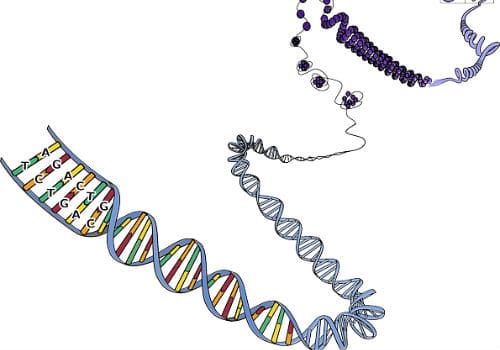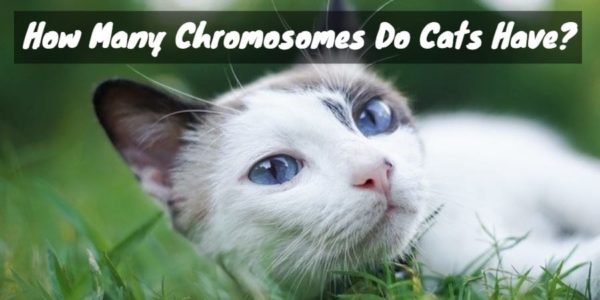Ever wondered about the world of genetics, especially when it comes to our feline friends? The science of genetic research, although a relatively recent addition to the science universe, has made giant strides over the last two centuries. It’s an exciting journey of discovery, from understanding that parents pass traits to their offspring to unraveling the dominance of certain traits over others.
With the advent of technologies like powerful computers, high-definition microscopes, and specialized lab equipment such as thermal cyclers, we have a front-row seat to the marvels of genetics. Today, we’re more capable than ever of extracting and analyzing genetic material from every species on Earth – including cats.
Remember those lessons about chromosomes from your high school biology class? Those tiny structures nestled in the nucleus of every cell are packed with DNA. What makes it even more fascinating is that each plant and animal species carries its own unique set of chromosomes. The number can swing wildly from species to species: think male jack jumper ants with a single chromosome, or certain Adder’s tongue ferns boasting a staggering 1260!
Now, here’s a question for you. How many chromosomes do cats have? What’s the story behind their genetic makeup, and how does it measure up to other animals? You might think you need a state-of-the-art biotech lab or at least a high-power microscope to delve into this but worry not. All you need to do is keep reading, and we will explore the fascinating world of cat genetics together.
Building Blocks: The Construction of Chromosomes
Breaking it Down

Ever wonder about the fantastic microcosm that dwells within each cell in our bodies? Let’s dive in and discover the magic of chromosomes and how they shape who we are.
Imagine the human body as a bustling city, teeming with cells. At the heart of each cell, much like the city center, lies the nucleus. This nucleus is the safe house for something truly spectacular – our chromosomes. These little wonders are the building blocks of our identity, carefully safeguarded within the nucleus. But here’s the cool part: they’re present in every single cell, ensuring plenty of backup copies. Think of them as the city’s blueprint, stored and duplicated at every corner.
Now, what does a chromosome look like, you ask? Picture an ‘X’. That’s the typical shape of a chromosome, flaunting two short arms and two long arms. But wait, some chromosomes like to switch things up. You might find some resembling an upside-down ‘V’, while others might look like a solitary bar.
Regardless of their shape, each chromosome is crafted from DNA. Imagine a spool of thread. The DNA, much like thread, is wound tightly around proteins. This compact combination creates a material known as chromatin. And it’s this chromatin that twists and loops around itself to form the distinctive shapes of the chromosomes.
Isn’t it fascinating how our bodies contain such complex and intricate machinery? Each cell, each chromosome, plays its part in the grand symphony of life.
Express Yourself
An individual’s DNA, which contains its genes — from Marriam-Webster: a unit of DNA that is usually located on a chromosome and that controls the development of one or more traits and is the basic unit by which genetic information is passed from parent to offspring — is divided up between the chromosomes, so all of them are needed to form a complete genetic portrait. If a chromosome is damaged or incomplete, it won’t usually affect genes on other chromosomes but can result in a genetic disorder. Genetic disorders have such all-encompassing symptoms because genes aren’t arranged categorically on the chromosome; a gene that controls eye color may be found right next to one that dictates toe length and another that determines the metabolic rate.
Chromosomes normally come in pairs, one from the mother and one from the father. Sperm and egg cells contain a random half of their respective individual’s DNA, and when they combine with each other a complete set is formed, creating a fetus with its own uniquely paired chromosomes. Individual genes are located at the same points on each chromosome, and the expression of a given gene depends on how it corresponds to its counterpart on the matching chromosome.

Sometimes one chromosome wins out and the other’s gene isn’t expressed at all. The prevailing gene is known as the dominant gene, which is a relative term; while some genes are usually dominant, they may lose out if paired with an even more dominant gene. The losing gene is called the recessive gene and though it isn’t expressed, it can still be passed down to offspring.
Other times, both genes mingle with each other and are expressed simultaneously. This is called codominance, and a well-known example is human blood type. Blood can be type A, type B, or type O, but sometimes both the A gene and the B gene are expressed, resulting in type AB blood.
Kitty’s Karyotype: All About Cat Chromosomes
Cat Genetics at a Glance
Ever pondered how many chromosomes our feline companions carry? Well, get ready for a fun fact: cats have a total of 38 chromosomes, neatly bundled into 19 pairs.
Now, one special pair among these carries an important responsibility – determining the cat’s gender. This pair is made up of what we call ‘sex chromosomes’, which are represented by either X or Y. Here’s where it gets really interesting. Female cats hold two X chromosomes, while males boast one X and one Y. So how is this decided? Mother cats always pass on an X chromosome. Father cats, on the other hand, can pass on either an X, creating a female kitty, or a Y, leading to a male one.
But, wait a minute! If only one pair of chromosomes determines sex, what about the other genes? That’s where the remaining 18 pairs of chromosomes, known as autosomes, come into play. Most of a cat’s genetic makeup is shaped by these autosomes. This is precisely why male and female cats look almost identical. Believe it or not, only about 5% of their DNA is linked to their sex.
Isn’t it fascinating how nature weaves such an intricate tapestry of life, even within our charming, whiskered friends? So the next time you see a cat, remember the incredible genetic journey it carries within.
Comparatively Close
All members of the cat family have very similar chromosomal makeups, which are called karyotypes. In fact, the karyotypes of various cat species are so similar that they can sometimes successfully breed with one another. This interspecies mating results in hybrids like the Bengal (a cross between a domestic cat and an Asian leopard cat) and the liger (a cross between a lion and a tiger.)
The slight chromosomal differences, however, can be enough to cause problems such as infertility. As such, many of these hybrids cannot themselves reproduce. They also carry a higher risk of severe birth defects and other health problems due to mismatched genes within their chromosome pairs.
Not So Different
At first glance, humans and cats have very different genes. For starters, humans have 23 pairs of chromosomes, four more than cats have. And on a less microscopic level, we just look completely different: we have fewer legs, less hair, no tails, no whiskers, opposable thumbs … the list goes on and on.
Humans and cats branched off from each other on the great tree of evolution over 100 million years ago, so it seems obvious that our two species are so radically different. But despite the staggering amount of time that’s passed since we were one, surprisingly little has changed deep down in our chromosomes.
We share a shocking 90% of our DNA with our pet cats. For every way we differ from cats, there are nine ways in which we’re the same.
The most obvious similarity is our sex chromosomes: we also receive an X chromosome from our mother while our father’s contribution determines our sex. If we end up with an XX pair, we’re female, and if we get an XY pair, we’re male. The exact genes that comprise our chromosomes are different than cats’, but the way our sexes are determined is identical.

Additionally, many of our chromosomes are laid out similarly or even mostly identical to cats’ chromosomes. They’re named and ordered differently, but the same sequences of genes can be found in both of our species. This makes cats invaluable to science, particularly the fields of medicine and biotechnology, as their chromosomal similarity to humans allows us to better understand diseases and medications.
Genetic Oddities: Common Cat Gene Variations
Cats of a Different Color
Have you ever noticed that calico and tortoiseshell cats are almost always female, while orange cats are almost always male? It’s not your mind playing tricks on you – it’s just genetics!
Cat fur color is affected by many genes spread out over the various chromosomes, but the base color is determined by a gene on the X chromosome. This gene can either be black or orange, but not both on the same chromosome. All other cat colors are based on one of these two colors.
Female cats have two X chromosomes, which means that one can carry the black gene while the other carries the orange gene. The genes are then expressed co-dominantly, creating the black and orange tortoiseshell pattern. Calico cats are tortoiseshells with white spots or patches; white fur is not linked to the sex chromosomes but rather to the KIT gene found on chromosome B1.
Because male cats only have one X chromosome, they can’t display both black and orange coloration at once. However, they do have the upper hand when it comes to full orange coats. 81% of orange cats are male, and the reason for this comes down to probability.
Male cats only have one fur color gene; if that gene is for orange fur, then the cat will be orange. Females, on the other hand, will only be orange if both of their parents contributed the orange gene – effectively halving their probability of being orange.
Odd Ones Out
Despite these sex-linked differences, some male calicos and tortoiseshells still exist. Several different genetic anomalies can be responsible for this rare phenomenon. If you meet a male cat with black and orange fur, consider yourself lucky: he may quite literally be one in a million!
The orange gene is considered a mutation of the black gene, meaning that the gene’s original state was black. Sometimes a male cat fetus with the orange gene will suddenly revert back to the black gene early on in the womb. When this happens, the cat will have black and orange fur, with the amount of black varying depending on when the gene reverted – any skin that developed before the change will be orange, and any that developed after will be black.
Sometimes an egg or sperm cell is abnormal but still produces a viable fetus. One such abnormality is an extra X chromosome, resulting in a set of XXY sex chromosomes; two X chromosomes mean two opportunities for fur color gene expression. Cats with this condition, which is known as Klinefelter syndrome and also occurs in humans, have male reproductive organs but are infertile and can have other health conditions such as low bone density and cognitive problems.
Finally, male cats can be black and orange due to chimerism, a rare condition in which two fertilized eggs merge together in utero. A cat’s DNA is determined at the moment of fertilization, so if one egg would have been a black male and the other an orange male, the chimera cat will contain both sets of DNA in different parts of its body. In other words, the orange and black parts of the cat will be genetically distinct from one another – literally two cats in one!
White Fur, Blue Eyes, Can’t Hear

It’s often claimed that all-white cats with blue eyes are deaf. While this isn’t strictly true, it’s a reliable rule of thumb, as up to 85% of white cats with two blue eyes are completely deaf. It’s not limited to blue eyes, either – even white cats without blue eyes experience deafness at a rate of around 20%, far higher than cats with other fur colors.
All-white cats with one blue eye and one non-blue eye (a condition called heterochromia) may only be deaf in one ear. In these cases, the deaf ear is usually on the same side as the blue eye. Total deafness is still a strong possibility, occuring at a rate of around 40% in all-white heterochromic cats.
Congenital deafness appears to be highly correlated with the KIT gene on autosome B1, which determines how much (if any) of a cat’s fur is white. The gene can take one of four states: no white, white gloves, white spotting and dominant white. The dominant white gene makes the cat completely white and also dramatically increases its likelihood of having blue eyes, though the reason for this is not yet known.
In cats with the dominant white gene, the hearing receptor may completely disintegrate within a few weeks after birth, before the ears even open. These cats never hear anything and face extra difficulties throughout their lives, but they still display that trademark feline resourcefulness and may even experience the other senses at heightened levels. Cats with congenital deafness frequently go on to lead happy lives that are just as long as those of cats without it.
"In ancient times cats were worshipped as gods; they have not forgotten this."
-- Terry Pratchett





